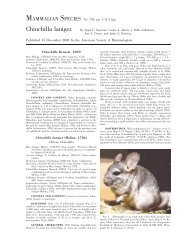Brugia Malayi - Clark Science Center - Smith College
Brugia Malayi - Clark Science Center - Smith College
Brugia Malayi - Clark Science Center - Smith College
Create successful ePaper yourself
Turn your PDF publications into a flip-book with our unique Google optimized e-Paper software.
Long-Term Fatigue Causes Morphological Changes in Microglia<br />
Helen Queenan<br />
It is important to understand where the most noticeable effects of fatigue are concentrated in the brain in order to find treatments<br />
for this disorder. One factor that has been closely related in helping to understand this disease more fully is the activation of<br />
microglia. Through inducing long-term fatigue in animals, either through exterior manipulation, such as drugs or through natural<br />
causes, or age, we can examine and pinpoint where or what effects activated microglia may cause. The purpose of our study was<br />
to determine differences between activated microglia in young and aged mice. It was also important to discover where in the brain<br />
activated microglia are most concentrated during fatigue. With this, we can target that area and in the future create a drug that<br />
specifically targets the microglia in that brain region. In order to accomplish this, a quantitative method needed to be tested and<br />
finalized. The experiments conducted in order to answer some of these concerns included running immunocytohistochemistry<br />
and obtaining a quantification method for the results from the immunocytohistochemistry. Female mice, young and aged, were<br />
euthanized. Their brains were removed and frozen on dry ice. The brains were sliced at 20 micrometer sections and sliced via<br />
a cryostat. Cryosections were then fixed and run through an immunocytohistochemistry protocol. At the end, sections were<br />
incubated in DAB, dehydrated, and ready for analyses. Pictures were obtained and analyzed by Image J. Image J was used as a way<br />
to compare brain regions, from a young and aged mouse, by quantifying the activated microglia in the brain regions. Results from<br />
our experiments suggest that there is a morphological change in activated microglia in mice experiencing long term fatigue, and<br />
a method found to effectively quantify microglia will prove effective when determining where, in which brain regions, activated<br />
microglia are most concentrated. Future research would observe the differences in Interlukin-1 treated young mice in addition to a<br />
difference between aged mice treated with Interlukin-1. (Supported by the Frances Baker Holmes Fund)<br />
Advisor: Mary Harrington<br />
A<br />
B<br />
Figure 1: Hippocampus of (A) aged mouse (40X) and (B) young mouse (40X)<br />
A<br />
Figure 2: Hippocampus of (A) aged mouse (4X) and (B) young mouse (4X)<br />
B<br />
B<br />
2012<br />
153

















